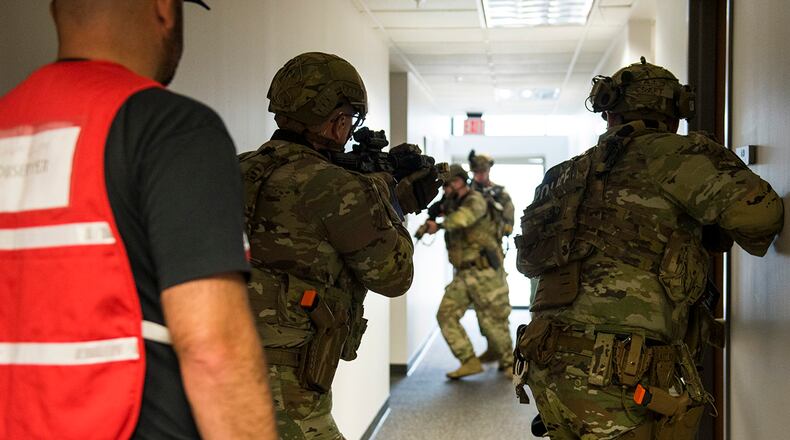Fortunately, this active shooter was not real.
The Aug. 10 base-wide exercise was planned months in advance to test WPAFB’s response to a real-world scenario.
“No one wants any of these events to happen, but we must prepare for the ‘when,’” said Roxie Viney, the 88th Air Base Wing inspector general’s inspection and exercise program chief. “We are a military installation and a target for active-shooter attacks. We conduct active-shooter exercises twice annually, and each time, we change the scenario to strengthen our emergency response forces.”
The IG’s wing inspection and exercise program is responsible for creating, planning and executing base exercises.
Garth Freund is one of four people who work in this office and was lead exercise controller for the Aug. 10 exercise. He began planning for it back in May.
“In the months leading up to any exercise, I’m reviewing Air Force and Department of Defense regulations and instructions to establish unit and wing objectives designed to test vital skills,” he said. “I’m also working with base commanders to identify important skills not covered in guidance that need to be tested. After the objectives are established, I’ll create a scenario that will steer units into a situation where they need to complete those tasks.”
The active-shooter exercise began shortly after 10 a.m. when the 88th Security Forces Squadron received a 911 call that “shots” were fired in Bldg. 1455 on Area A, a location that was carefully chosen.
Credit: (U.S. Air Force photo by Jaima F
Credit: (U.S. Air Force photo by Jaima F
“We put out a request to commanders six months before the exercise, asking if they would consider volunteering a facility — with the understanding that this exercise will take most of the day and that everyone in the building must play,” Freund said. “Also, we consider the facility location, specifically what impact it would have on the public.”
This scenario also provided training opportunities for other base organizations.
Medical and fire emergency responders gave first aid to the “wounded,” the Air Force Office of Special Investigations performed a crime-scene investigation, and the 788th Civil Engineer Squadron’s Explosive Ordnance Disposal Flight disarmed and disposed of two explosive devices.
Credit: (U.S. Air Force photo by Jaima F
Credit: (U.S. Air Force photo by Jaima F
“The exercise went very well,” Freund said. “It identified some areas that need work and it helped better prepare base personnel in the event this happened for real.”
The exercise was over after a few hours, but there’s still more work to do for the IG office. Freund will collect feedback from inspectors and brief 88 ABW leadership on the good and bad.
“We like to see strengths in a report, but it has been proven time and time again that if we don’t document the problem areas, they never get fixed,” Freund added. “If we can find and fix problems and come up with better ways to accomplish the mission, the exercise was a success for the 88th IG.”
Credit: (U.S. Air Force photo by Jaima F
Credit: (U.S. Air Force photo by Jaima F
About the Author



